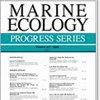海洋变暖和酸化条件下美洲龙虾的育雏行为
IF 2.1
3区 环境科学与生态学
Q2 ECOLOGY
引用次数: 0
摘要
摘要:不利的环境条件与理毛行为之间的关系是一个尚未解决的机制,气候变化可能会影响产卵动物的繁殖成功率。尽管对十足甲壳类动物胚胎的存活和发育很重要,但有卵雌性动物的育雏梳理行为可能会受到与气候变化相关的高能耗条件的影响,这可能会对雏鸟的健康和存活造成致命或亚致命的结果。尽管梳理育雏行为对繁殖具有潜在的重要性,但对于具有重要商业价值的海洋十足目动物--美国龙虾(Homarus americanus H. Milne Edwards, 1837)来说,梳理育雏行为尚未得到实证描述。我们在美洲龙虾胚胎发育的不同阶段探讨了梳理行为、温度和 pH 值之间的关系。在为期5个月的时间里,产卵雌性龙虾暴露在不同的生态相关温度和pH值条件组合中,包括反映海洋变暖(+4°C)、海洋酸化(-0.5 pH)以及变暖和酸化组合的条件。在多个时间点对龙虾的繁殖力、胚胎发育和雌性梳理行为进行了评估。随着胚胎发育的推进,龙虾用于扇动而非探测雏鸟的时间比例增加。在该实验中,卵的损失和任何测量的育雏行为都不会随温度或 pH 值的变化而显著改变。美国龙虾的繁殖似乎非常适合承受未来海洋酸化和变暖的条件,因为它能够在各种条件下保持稳定的雏鸟梳理和雏鸟死亡率水平。本文章由计算机程序翻译,如有差异,请以英文原文为准。
Brood-grooming behavior of American lobsters Homarus americanus in conditions of ocean warming and acidification
ABSTRACT: The relationship between adverse environmental conditions and grooming behavior is an unresolved mechanism whereby a changing climate may impact reproductive success in animals that brood their eggs. Although important to embryo survival and development in decapod crustaceans, brood grooming by ovigerous females may be impacted by energetically demanding conditions associated with climate change, which may contribute to lethal and sublethal outcomes for brood health and survival. Despite its potential importance to reproduction, brood-grooming behavior has not been empirically described in the American lobster Homarus americanus H. Milne Edwards, 1837, a commercially important marine decapod. The relationship between brood-grooming behavior, temperature, and pH was explored at different points in the embryogenesis of American lobsters. For a period of 5 mo, egg-bearing females were exposed to different combinations of ecologically relevant conditions of temperature and pH, including those reflecting ocean warming (+4°C), ocean acidification (-0.5 pH), and the combination of warming and acidification. Fecundity, embryo development, and female grooming behavior were assessed at multiple time points. The proportion of time that lobsters spent fanning, but not probing, their broods increased with advancing embryo development. Neither egg loss, nor any measured brood-grooming behaviors, varied significantly with temperature or pH in this experiment. American lobster reproduction appears well suited to tolerate future conditions of ocean acidification and warming based on the ability to maintain stable brood grooming and brood mortality levels under a range of conditions.
求助全文
通过发布文献求助,成功后即可免费获取论文全文。
去求助
来源期刊

Marine Ecology Progress Series
环境科学-海洋学
CiteScore
5.30
自引率
8.00%
发文量
238
审稿时长
3 months
期刊介绍:
The leading journal in its field, MEPS covers all aspects of marine ecology, fundamental and applied. Topics covered include microbiology, botany, zoology, ecosystem research, biological oceanography, ecological aspects of fisheries and aquaculture, pollution, environmental protection, conservation, and resource management.
 求助内容:
求助内容: 应助结果提醒方式:
应助结果提醒方式:


